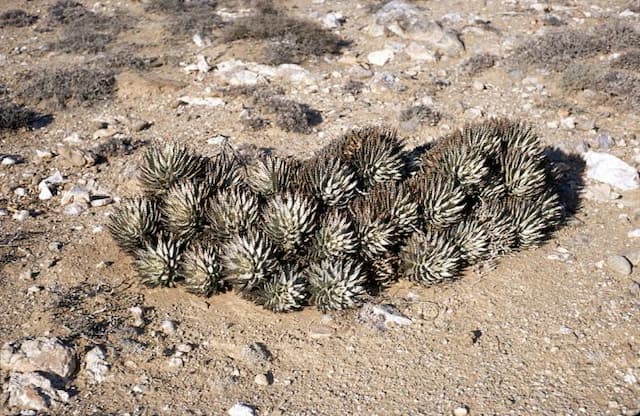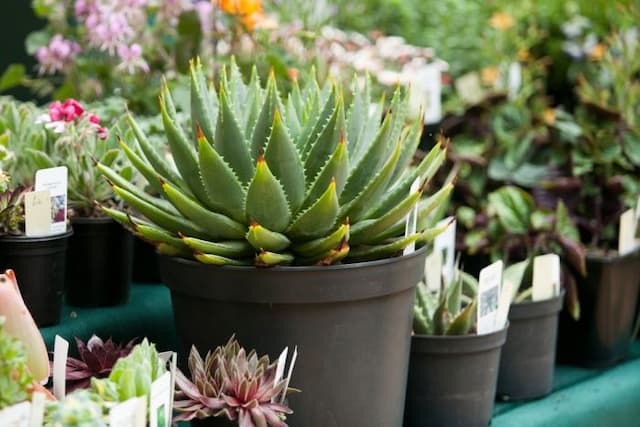Red Hot Poker Kniphofia 'Drummore Apricot'

ABOUT
The Kniphofia 'Drummore Apricot', commonly known as the Red Hot Poker or Torch Lily, is a perennial plant that is notable for its striking flower spikes. The plant forms a clump of grassy, evergreen foliage from which arise tall, stiff flowering stems. The long, tubular flowers are arranged in a dense, upright spike at the top of each stem, presenting a fiery display of color. As the name 'Drummore Apricot' suggests, the flowers of this cultivar exhibit shades of warm apricot, transitioning to a lighter hue as they age. The blossoms usually have a gradient effect, with the buds at the top of the spike being a richer, darker tone, reminiscent of a glowing ember, and the color softening as it moves down the spike. The foliage of the Red Hot Poker consists of narrow, arching leaves that are a deep, lush green, giving the plant a robust and textured appearance even when it is not in bloom. During the flowering season, the contrast between the vivid apricot-orange flower spikes and the green leaves creates an eye-catching display in the garden that both attracts viewers and serves as a magnet for pollinators like hummingbirds and bees. The plant's overall appearance is one of vibrant color and dynamic form, making it a popular choice for adding visual interest to borders, beds, and mixed garden settings.
About this plant
 Names
NamesFamily
Asphodelaceae
Synonyms
Red Hot Poker, Torch Lily, Poker Plant
Common names
Kniphofia 'Drummore Apricot'.
 Toxicity
ToxicityTo humans
Red hot poker is not generally considered toxic to humans. However, it is always wise to avoid ingesting plants that are not meant for consumption, as individual sensitivities can vary, and there could be adverse reactions such as gastrointestinal discomfort or allergic reactions for some people.
To pets
Red hot poker is not generally known to be toxic to pets. Similar to humans, pets should not consume non-food plants, as individual animals may have different sensitivities and may experience gastrointestinal upset or an allergic reaction if they ingest parts of the plant.
 Characteristics
CharacteristicsLife cycle
Perennials
Foliage type
Evergreen
Color of leaves
Green
Flower color
Apricot
Height
3-4 feet (0.9-1.2 meters)
Spread
2-3 feet (0.6-0.9 meters)
Plant type
Herb
Hardiness zones
6
Native area
South Africa
Benefits
 General Benefits
General Benefits- Attracts Pollinators: The vibrant blooms of Red Hot Poker are irresistible to hummingbirds, bees, and butterflies, helping to support local ecosystems.
- Drought Tolerance: Once established, Red Hot Poker plants are highly resistant to drought, making them suitable for areas with low rainfall or water conservation needs.
- Low Maintenance: They require minimal care once they are settled in the landscape, making them a great choice for gardeners seeking low-maintenance plants.
- Long Blooming Season: With a generous blooming period stretching from early to late summer, Red Hot Poker provides enduring color and interest in the garden.
- Deer Resistance: Red Hot Pokers are generally not favored by deer, which can be particularly beneficial in areas where deer browsing is a problem.
- Landscape Versatility: These plants can be used in a variety of garden settings, including borders, mass plantings, and as architectural focal points.
- Hardiness: Red Hot Poker is hardy in a variety of climate conditions and can thrive in USDA zones 5 through 9.
- Winter Interest: The seed heads and foliage often persist into winter, providing texture and interest even during the colder months.
 Medical Properties
Medical PropertiesThis plant is not used for medical purposes.
 Air-purifying Qualities
Air-purifying QualitiesThis plant is not specifically known for air purifying qualities.
 Other Uses
Other Uses- As an artistic muse: The striking flowers of the Red Hot Poker can inspire painters and photographers, making it a common subject in botanical and garden art.
- In eco-friendly dye-making: The vibrant colors of the plant could potentially be used to create natural dyes for textiles or art projects.
- As a teaching tool in botany: Because of its unique floral structure, it can be used to educate students about pollination and plant anatomy.
- Habitat support: This plant can be included in garden designs aiming to support local wildlife, as it is attractive to hummingbirds and beneficial insects.
- Themed garden displays: Red Hot Pokers can be used in fire or volcano-themed gardens due to their fiery flower spikes.
- In crafting and floristry: The dried flowering spikes can be used in floral arrangements and crafts for their interesting texture and shape.
- As a natural pest deterrent: The Red Hot Poker may be planted around vegetable gardens to deter certain animals and pests with its sharp leaves.
- In culinary presentations: Although not edible, its vibrant flowers can be used as garnish for food plating to add an exotic appeal.
- For seasonal celebrations: It can be integrated into displays for events or holidays that celebrate warmth and fire, like summer solstices or fire festivals.
- In climate education gardens: The Red Hot Poker, being drought-resistant, can be used in gardens designed to educate about xeriscaping and water conservation practices.
Interesting Facts
 Feng Shui
Feng ShuiThe Red Hot Poker is not used in Feng Shui practice.
 Zodiac Sign Compitability
Zodiac Sign CompitabilityThe Red Hot Poker is not used in astrology practice.
 Plant Symbolism
Plant Symbolism- Standout Appearance: The fiery and unique blooms of the Red Hot Poker symbolize a distinctive or bold personality, standing out in a crowd.
- Attraction: The bright colors of the Red Hot Poker flowers are known to attract hummingbirds and bees, representing allure and the ability to draw others in.
- Strength: These plants can tolerate challenging conditions such as drought, symbolizing resilience and fortitude.
- Warmth: The warm colors of Red Hot Poker blooms represent comfort, energy, and a friendly disposition.
 Water
WaterThe Red Hot Poker should be watered deeply to ensure the roots get ample moisture, typically receiving about 1 inch of water per week. During hot or dry periods, increase watering to every couple of days to maintain consistent soil moisture. However, ensure that the soil drains well between waterings to prevent root rot. It is best to water early in the morning to reduce evaporation and allow foliage to dry out during the day. If possible, avoid overhead watering to minimize disease risks.
 Light
LightRed Hot Pokers thrive in full sun conditions, requiring at least 6 hours of direct sunlight daily. They perform best when placed in a sunny spot that receives unfiltered sunlight throughout the day. Avoid shady areas as insufficient light can lead to poor flowering and a weakened plant.
 Temperature
TemperatureThe Red Hot Poker prefers warmer climates and can tolerate temperatures as low as 30°F, though it thrives in areas where the temperature ranges between 60°F and 90°F. It may need protection from frost in colder climates. Avoid exposure to prolonged temperatures below freezing to prevent damage to the plant.
 Pruning
PruningPruning Red Hot Pokers involves deadheading spent flowers to encourage additional blooms and removing old foliage in late winter or early spring. Cut back the flower stalks to the base of the plant post-bloom to keep it tidy. Perform a more thorough clean-up once a year, removing dead or damaged leaves to promote healthy new growth.
 Cleaning
CleaningAs needed
 Soil
SoilRed Hot Poker thrives in well-drained soil with a mix of loam, sand, and compost to ensure adequate drainage and fertility, with a pH between 6.0 and 7.0.
 Repotting
RepottingRed Hot Poker plants typically do not need frequent repotting and can stay in the same pot for several years until they outgrow their space.
 Humidity & Misting
Humidity & MistingRed Hot Poker is adaptable to a wide range of humidity levels and does not have specific humidity requirements, making it suitable for various outdoor climates.
 Suitable locations
Suitable locationsIndoor
Ensure bright light and good airflow for indoor Red Hot Poker growth.
Outdoor
Plant in full sun, well-draining soil; water deeply but infrequently.
Hardiness zone
6-9 USDA
 Life cycle
Life cycleThe Red Hot Poker 'Drummore Apricot' begins its life cycle when the seeds germinate, typically in the spring after they have been exposed to stratification or have been sown directly into the ground. The seedlings develop into a rosette of leaves and establish a strong root system. As the plant matures, usually in the second year, it sends up flower spikes from the center of the rosette, blooming in high summer with apricot-colored flowers that attract hummingbirds and bees. After flowering, the plant sets seed, which can be collected for propagation or allowed to fall and potentially germinate naturally. Throughout its life, the plant will produce new leaves from the base, and old, spent leaves will die back, especially after winter, requiring seasonal cleanup. The plant can live for several years, forming larger clumps with multiple flowering stalks, and can be divided every few years to maintain vigor and propagate new plants.
 Propogation
PropogationPropogation time
Spring to Summer
The Red Hot Poker plant, specifically Kniphofia 'Drummore Apricot', is usually propagated by division in the spring. This method involves carefully lifting the plant's clump from the ground once the soil is workable and the threat of frost has passed. The clump should be divided into smaller sections, making sure that each section has at least one growth point. The divisions can then be replanted into well-draining soil, spaced approximately 18 inches (45.72 centimeters) apart to allow sufficient room for growth. It's essential to water the new plants thoroughly after planting to help establish them.









